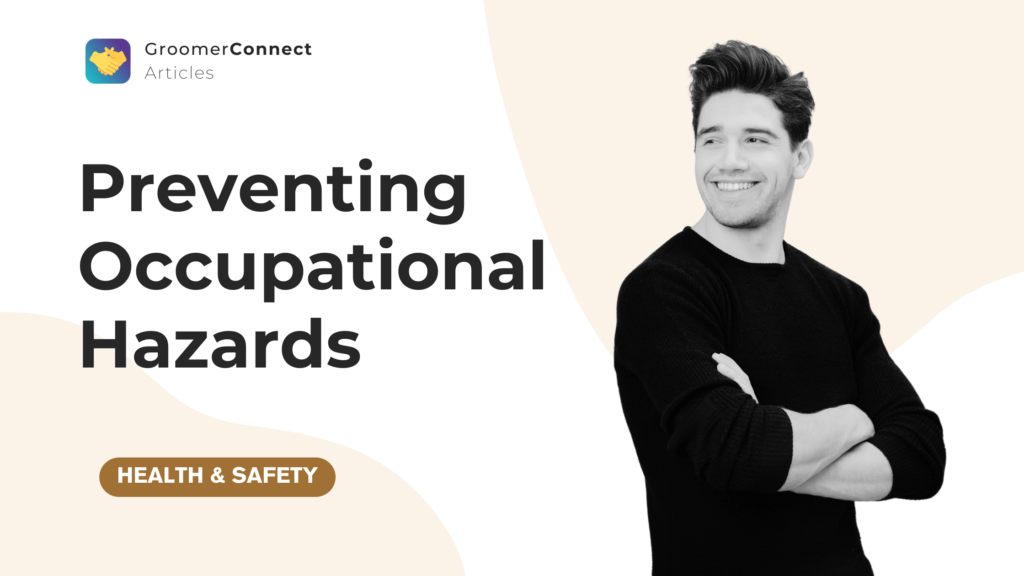Health and Safety Training for Pet Groomers

Pet grooming is a rewarding profession that brings joy to both groomers and their furry clients. However, it also comes with inherent risks and hazards that can pose threats to the health and safety of groomers. From handling sharp tools to managing unpredictable pet behavior, pet groomers face a variety of occupational hazards in their daily work. In this article, we’ll explore the importance of health and safety training for pet groomers and provide essential tips for preventing occupational hazards in the grooming salon.
Understanding Occupational Hazards
The first step in preventing occupational hazards is to understand the risks associated with pet grooming thoroughly. Common hazards in the grooming salon include cuts and lacerations from sharp grooming tools, repetitive strain injuries from prolonged grooming sessions, exposure to grooming chemicals and allergens, and bites or scratches from frightened or aggressive pets. By identifying potential hazards, pet groomers can take proactive measures to mitigate risks and protect their health and well-being. Moreover, conducting regular risk assessments and staying updated on industry safety standards can further enhance the effectiveness of hazard prevention strategies, ensuring a safer working environment for both groomers and pets alike.
Providing Comprehensive Training
Effective health and safety training are essential for pet groomers to minimize the risk of accidents and injuries in the workplace comprehensively. Ensure that all groomers and staff members receive comprehensive training on safe grooming practices, proper handling techniques, and emergency procedures. Topics to cover in training sessions may include pet behavior assessment, safe restraint methods, ergonomic grooming techniques, proper tool handling and maintenance, and the use of personal protective equipment (PPE). By equipping groomers with the knowledge and skills they need to work safely, salon owners can create a culture of safety and reduce the likelihood of accidents occurring. Additionally, offering ongoing training and professional development opportunities allows groomers to stay updated on the latest safety protocols and industry best practices, fostering a culture of continuous improvement and commitment to safety within the grooming salon.
Practicing Safe Handling Techniques
Proper handling techniques are critical for preventing injuries when grooming pets effectively. Groomers should always approach pets calmly and gently, using positive reinforcement techniques to build trust and cooperation. When handling sharp grooming tools such as scissors, clippers, and blades, groomers should exercise caution and focus to avoid accidental cuts or punctures. Additionally, using appropriate restraint devices, such as grooming loops, harnesses, or muzzles, can help keep pets secure and prevent bites or scratches during grooming procedures. Moreover, regular training and skill development sessions focused on safe handling techniques can help groomers refine their skills and enhance their ability to handle pets safely and effectively, reducing the risk of accidents and injuries in the grooming salon.
Implementing Safety Protocols
Establishing clear safety protocols and procedures is essential for maintaining a safe grooming environment. Develop written protocols for handling emergencies, such as pet injuries, accidents, or grooming-related incidents. Ensure that all staff members are familiar with these protocols and know how to respond effectively in emergency situations. Regularly review and update safety protocols as needed to address any emerging hazards or concerns in the grooming salon. Moreover, conducting regular safety audits and inspections can help identify potential hazards and ensure compliance with safety regulations and standards, further enhancing the effectiveness of safety protocols and procedures in the grooming salon.
Using Personal Protective Equipment (PPE)
Personal protective equipment (PPE) plays a vital role in protecting pet groomers from occupational hazards effectively. Groomers should wear appropriate PPE, such as gloves, aprons, goggles, and masks, when handling grooming chemicals, sharp tools, or potentially hazardous materials. PPE helps minimize exposure to allergens, chemicals, and biological hazards, reducing the risk of skin irritation, respiratory problems, and other health issues. Ensure that PPE is readily available and properly maintained in the grooming salon, and encourage groomers to use it consistently to protect their health and safety. Moreover, providing training on proper PPE usage and maintenance can help ensure that groomers use PPE effectively and adhere to safety guidelines and protocols in the grooming salon.
Prioritizing Ergonomics
Ergonomic considerations are essential for preventing musculoskeletal injuries and promoting long-term health and well-being among pet groomers. Salon owners should invest in ergonomic grooming equipment, such as adjustable grooming tables and ergonomic grooming tools, to minimize strain and fatigue during grooming sessions. Encourage groomers to take regular breaks, stretch, and practice good posture to reduce the risk of repetitive strain injuries and musculoskeletal disorders. Providing a comfortable and ergonomic workspace can help groomers stay healthy, happy, and productive in their profession. Additionally, offering ergonomic assessments and consultations can help identify potential ergonomic hazards and provide personalized recommendations for improving ergonomics in the grooming salon, further enhancing the effectiveness of ergonomic initiatives and promoting a safer and healthier working environment for groomers.
In conclusion, health and safety training are essential components of a pet groomer’s skill set, helping to prevent occupational hazards and promote a safe and healthy working environment. By understanding occupational hazards, providing comprehensive training, practicing safe handling techniques, implementing safety protocols, using personal protective equipment, and prioritizing ergonomics, pet groomers can protect their health and well-being while delivering quality care to their furry clients. So, prioritize safety in the grooming salon because when groomers feel safe and supported, everyone – pets and people alike – benefits.
